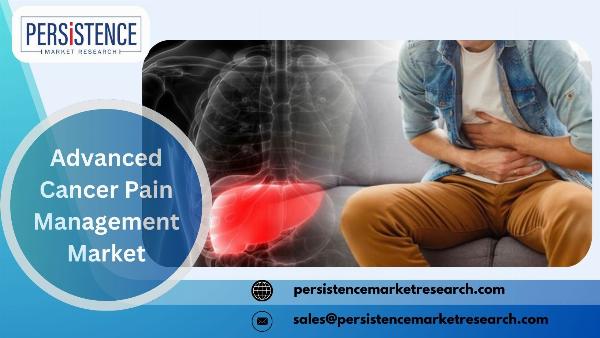What’s Fueling the Advanced Cancer Pain Management Market?

Strong 8k brings an ultra-HD IPTV experience to your living room and your pocket.
Introduction
Cancer pain management is a critical aspect of oncology care, aimed at improving the quality of life for patients suffering from cancer-related pain. As the prevalence of cancer continues to rise globally, the advanced cancer pain management market is experiencing significant growth. This article delves into the key drivers fueling this market, including technological advancements, evolving treatment paradigms, increasing cancer incidence, and enhanced patient awareness. The global Advanced Cancer Pain Management Market is forecast to expand at a CAGR of 4.9% and thereby increase from a value of US$ 7.2 Bn in 2024, to US$ 10.1 Bn by the end of 2031.
1. Technological Advancements in Pain Management
Recent innovations in medical technology have revolutionized cancer pain management, driving market growth. Advanced devices and systems are improving the precision and effectiveness of pain management strategies. Notable advancements include:
• Targeted Drug Delivery Systems: Innovations like implantable drug delivery systems and programmable infusion pumps allow for precise and controlled administration of pain medications. These systems reduce side effects and enhance patient comfort.
• Neurostimulation Devices: Devices such as spinal cord stimulators and deep brain stimulators are increasingly used to manage chronic pain. These technologies work by modifying the way pain signals are processed by the nervous system, offering relief to patients who do not respond well to conventional medications.
• Wearable Pain Management Devices: Emerging wearable technologies, such as transcutaneous electrical nerve stimulation (TENS) units, offer non-invasive pain relief. These devices are designed for ease of use and can be integrated into patients' daily lives, providing continuous pain management.
2. Evolving Treatment Paradigms
The approach to managing cancer pain has evolved significantly, with a shift towards a multimodal pain management strategy. This paradigm integrates various treatment modalities to address different aspects of pain. Key trends include:
• Personalized Pain Management: Personalized medicine is making its way into pain management, with treatments tailored to the individual’s genetic profile, pain type, and cancer stage. This approach aims to maximize efficacy and minimize side effects.
• Combination Therapies: Combining pharmacological treatments with non-pharmacological methods, such as physical therapy and cognitive-behavioral therapy, has proven effective in managing complex cancer pain. This holistic approach addresses the physical and psychological dimensions of pain.
• Emergence of Novel Analgesics: The development of new analgesic drugs, including novel opioids with reduced addiction potential and non-opioid pain relievers, is expanding treatment options. Research into compounds such as cannabinoids and neurokinin-1 antagonists is also contributing to the growth of the market.
3. Increasing Cancer Incidence and Prevalence
The rising incidence of cancer worldwide is a significant driver of the advanced cancer pain management market. Factors contributing to this increase include:
• Aging Population: As the global population ages, the prevalence of cancer rises. Older adults are more likely to develop cancer, leading to increased demand for effective pain management solutions.
• Advancements in Cancer Detection: Improved screening and diagnostic technologies lead to earlier detection of cancer, resulting in a higher number of patients requiring pain management throughout their treatment journey.
• Rising Cancer Survivorship: Advances in cancer treatments have led to increased survival rates, but many survivors experience chronic pain as a long-term side effect of their treatment. This growing population requires ongoing pain management solutions.
4. Enhanced Patient Awareness and Advocacy
Patients and caregivers are becoming more informed about cancer pain management options, contributing to market growth. Factors include:
• Increased Access to Information: The internet and social media have made information about cancer pain management more accessible. Patients are more likely to seek advanced treatment options and advocate for comprehensive pain management.
• Patient Advocacy Groups: Organizations dedicated to cancer care and pain management are raising awareness about the importance of effective pain control. These groups often work to influence policy and improve access to advanced pain management therapies.
• Educational Campaigns: Initiatives aimed at educating healthcare professionals about the latest advancements in pain management are improving treatment standards and driving market growth.
5. Regulatory and Reimbursement Landscape
The regulatory environment and reimbursement policies play a crucial role in shaping the advanced cancer pain management market. Key factors include:
• Regulatory Approvals: The approval of new pain management drugs and devices by regulatory agencies, such as the FDA and EMA, facilitates market growth. Streamlined approval processes for innovative treatments can accelerate their availability to patients.
• Reimbursement Policies: Comprehensive reimbursement policies that cover advanced pain management therapies can significantly impact market growth. Payers and insurance providers are increasingly recognizing the value of effective pain management in improving patient outcomes and reducing healthcare costs.
• Market Access Initiatives: Efforts to improve market access for new pain management technologies, including pricing and reimbursement strategies, are vital for expanding the adoption of advanced treatments.
6. Emerging Market Opportunities
The advanced cancer pain management market is not limited to developed regions. Emerging markets offer significant growth opportunities due to:
• Rising Healthcare Infrastructure: Improving healthcare infrastructure in emerging markets is enhancing access to advanced pain management therapies. Investments in medical facilities and technology are driving market growth in these regions.
• Growing Awareness and Education: Increased awareness about cancer pain management and ongoing educational efforts are expanding the market in emerging economies. As healthcare systems in these regions evolve, the demand for advanced pain management solutions is expected to rise.
• Economic Growth: Economic development in emerging markets is leading to higher healthcare spending, including investments in cancer care and pain management. This trend is creating new opportunities for market players.
Conclusion
The advanced cancer pain management market is experiencing robust growth driven by technological advancements, evolving treatment paradigms, increasing cancer incidence, and enhanced patient awareness. As the global landscape of cancer care continues to evolve, ongoing innovations and strategic initiatives will play a pivotal role in shaping the future of pain management. By addressing the complex needs of cancer patients and leveraging emerging opportunities, stakeholders in the market can contribute to improved outcomes and a better quality of life for those affected by cancer-related pain.
Follow Us: LinkedIn | Medium | Twitter
Note: IndiBlogHub features both user-submitted and editorial content. We do not verify third-party contributions. Read our Disclaimer and Privacy Policyfor details.


